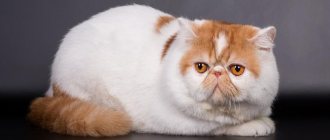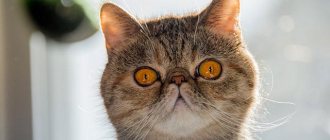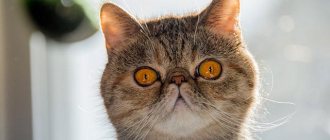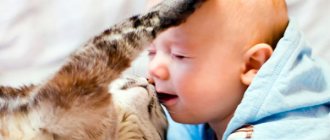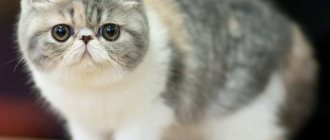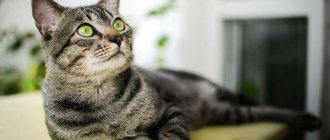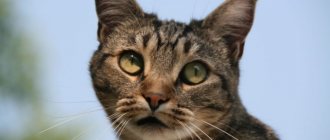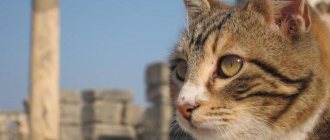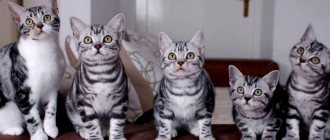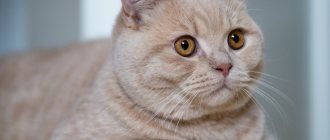History of the breed
The first exotic cat appeared due to a spontaneous combination of genes.
In an effort to achieve new features of appearance, they were crossed with the American Shorthair and Persian breeds. The goal was the desire to obtain a special physique. The resulting offspring received many traits from Persian cats, namely their doll-like face. In 1966, Jane Martink showed the world a new breed, which was called the Exotic Shorthair. These animals took a long time to achieve their official recognition. were skeptical about it, considering them an encroachment on the purity of the breed. However, there were those who were able to see the prospects of new cats, they took part in its formation and spread. Two of them are especially worth noting: Doris Walkinstick and Caroline Bussey. They put a lot of work and effort into this work. Burmese cats and the Russian Blue breed also took part in the selection. The experiments ended when short-haired offspring were obtained. This feature was successfully fixed in the genome of animals. At this time, this breed can only be crossed with Persian cats. In 1990, felinologists adopted a standard that completely replicates the requirements for “Persians”, except for some characteristics - body length, coat characteristics. All changes that are made to the standards of Persian cats are also relevant for exotics. The exotic shorthair cat has similar appearance characteristics to the Persians.
Exotic appearance
Exotic kitten
The ideal exotic shorthair cat looks like a well-balanced animal with strong, even somewhat heavy bones. The coat gives the outline softness and roundness, the expression of the muzzle conveys complacency and calmness of character.
Head
Round in shape, quite massive. The skull is very wide with a round bone structure. The chin is well developed and round in shape. The jaws are strong and wide, the cheeks are full.
Eyes
The eyes of an exotic cat are located far from each other at the same level. The shape is large and round.
Ears
Small size, round shape. Set wide and low on the head, slightly tilted forward. Not very open at the base.
Nose
Wide, short and upturned. “Stop” is located clearly between the eyes.
Exotic cat face
Body
The body of exotics is medium or closer to large in size. Squat, with well-developed muscles, without signs of obesity. The chest is wide, the shoulders are massive.
Limbs
Exotic standing on his hind legs
Strong, short, massive. The front ones are straight, the rear ones are straight when viewed from behind.
Paws
Exotic paws are large and round. There are 5 toes on the front paws, 4 on the hind paws.
Tail
Proportional to body length, although it can rather be defined as short. No bends. The animal is held at a level below the back.
Wool
The exotic cat's coat is thick and plush, with a rich undercoat. Middle length. It feels very soft to the touch.
Disqualifying features
Visible weakness of the hind limbs, tail defects, number of toes that does not meet the standard. Strabismus, asymmetry of the muzzle or head. Visible deformities of the spine. White toes and non-blue eyes for color points.
Character of an exotic cat
The main qualities of an exotic cat are friendliness, moderate playfulness, and curiosity. They have proven themselves well in large families, but have many positive reviews from single people. They quickly and strongly become attached to their owner, but are not particularly intrusive. The pet will calmly wait for its person to come home from work, and then sit comfortably on his lap.
Question to the expert
Is it easy for exotic kittens to get used to their new home?
Exotic kittens have good adaptive skills. They quickly get used to new conditions and do not experience much stress. The main thing is that he gets to know his surroundings.
They have the ability to react sensitively to a person’s mood. If he has difficulties at work, the pet will make every attempt to calm and comfort his owner. These cats are playful and active.
They enjoy running and catching balls or imaginary prey, exercising their hunter instincts. The most popular activity for them can be called catching their own tail. You can safely leave children with these animals without fear of consequences, but with strangers, they are cautious and wary.
Interesting read: all the information about British cats.
Psychology
Exotics have a calm disposition, although young individuals occasionally run “races” around the house, flexing their powerful muscles.
In addition, Snoopy is silent; they rarely give voice, only when they really need something.
Exotics are selective in their affections and at first look closely at their owner.
However, if you manage to find a rapport with the plush charm, you will receive almost dog-like affection.
An exotic cat needs communication and becomes attached to a specific person.
You can read about other sociable cat breeds here:
This may cause some inconvenience if you need to leave your pet - exotic cats, unlike Scottish Straights or Scottish Folds , feel sad when separated.
But they can handle any type of transport well and travel willingly.
If you already have other pets - cats or dogs - in your house, the conflict-free Snoopy will become an excellent companion cat for them.
Yes, yes, the exotic cat can read. You can discuss a book you recently read with him. True, he will keep his opinion to himself
Education and training
Raising or training this cat is quite easy. These are smart animals that respect their owner, observing the rules of behavior established by him. They quickly get used to the tray and are not inclined to misbehave, especially if their upbringing began in childhood.
With enough attention and time, they can be taught simple tricks and commands. This requires patience. If the animal fulfills the command correctly, it must be rewarded. Rudeness or physical force can destroy the trust between a person and an animal.
Shorthair exotic.
Basics of a healthy diet
Breeders usually use premium ready-made food for feeding. They already have a balanced composition, all the necessary substances - vitamins, minerals, proteins, normal fat content. Exotic kittens quickly get used to a certain diet; any changes in it can lead to problems with the digestive system. It is convenient to monitor proper weight gain using a table of exotic weights by month in the first 2 years of life.
Table of weight of exotic kittens in the first 2 years of life.
These cats have a good appetite, which means they have a high risk of gaining excess weight if they are not properly active. The food portion is 150 grams of food per day, for a girl – 130-140 grams. Food should be given 2-3 times a day, small kittens are fed more often - 4-5 times.
Long-haired exotic cat.
How to organize natural nutrition
An exotic cat, as natural food, should have a diet consisting of:
- rabbit, veal, chicken, turkey;
- fermented milk products – kefir, yogurt, fermented baked milk;
- oatmeal and rice porridge cooked in water;
- low-fat cheese.
Prohibited foods for them are: whole milk, fatty meat, potatoes, any bones, especially small fish.
Care
Caring for exotics is not as simple as we would like, but there are no particular difficulties. The features of their care are the same as those of the Persian. They are associated with the characteristics of their health - some physiological deficiencies:
- Difficulty breathing (due to a flattened nose), which is sometimes accompanied by snoring;
- Deformation of the jaw (teeth);
- Tearing, due to which the animal’s eyes need to be monitored daily.
Otherwise, these cats have fairly good health, which they inherited from their second parent - the “American”. If we talk about caring for exotics, in addition to washing the eyes, then we must not forget about the following points:
- take care of the claws by providing a scratching post, do not forget to trim the tips of the claws;
- comb the hair (once a week) and wash the cat once a season (three months), but more often during the molting period;
- After washing, it is advisable to dry the cat's fur, since the undercoat is quite thick and takes a long time to dry. If you don't help your cat dry out, it may catch a cold;
- Do not forget about proper feeding (do not feed human food): balance and vitamins;
- It is necessary to periodically remove worms and fleas from your cat.
Try to give love to the exotic and give more attention, since this is the main condition for their life expectancy (from loneliness they become depressed and die much earlier).
Health and disease of the breed
The exotic Persian cat has inherited a number of diseases to which Persians are predisposed.
One of the most common problems is problems with the eyes, namely increased levels of tearfulness. The nasolacrimal duct is shorter in exotics than in other cat breeds. It is necessary to remove these contaminants every day; if this procedure is not carried out, there is a risk of conjunctivitis.
They often suffer from colds, gum inflammation, and kidney problems. Anatomically, they have a curved lower jaw, which makes it difficult for them to eat. From their Persian relatives, exotics acquired a tendency to certain diseases.
Polycystic kidney disease develops with a probability of up to 80% if this disease was diagnosed in one of the kitten's parents. Another disease characteristic of the breed is cardiomyopathy. With this pathology of the heart, the left ventricle suffers. Symptoms of the development of the disease are:
- frequent shortness of breath;
- pallor of mucous membranes;
- fatigue.
Exotic kittens may not show any signs of these diseases at an early age. The lifespan of this breed is on average 13-14 years, but there are individuals that live up to the age of 18 years.
How to choose a kitten
Exotic kittens endear you from the very first visit to a breeder or nursery. Little exotics resemble a beautiful plush toy. When choosing, you need to pay attention to the pedigree and parents, the state of his health. It is recommended to choose a reliable nursery that has many positive reviews, recommendations, and many years of experience working with the breed. Often, unscrupulous sellers, under the guise of exotics, offer British dogs with an admixture of the Persian breed. But mixed-breed kittens should cost less. There are different crosses of exotics:
- American exotic;
- exotic extreme;
- lop-eared exotic.
Crossing exotics with third-party breeds is prohibited, and buying such a kitten for the purpose of breeding threatens poor health and future offspring not meeting recognized standards.
How much does an exotic cat cost?
The exotic breed belongs to the middle price segment. The cost of kittens ranges from 15,000 to 70,000 rubles. Pricing is influenced by:
- pedigree;
- parents' title;
- the kitten belongs to a certain class.
The most expensive is the show class. Such cats do not have any appearance flaws. Pet class animals cannot take part in breeding work and are subject to mandatory sterilization. But this does not affect their character, loyalty and love for their owner. An exotic kitten of this class costs up to 7,000 rubles.
Interesting read: everything about the character and habits of Maine Coons.
Nicknames for exotic cats
A kitten of any breed should have a beautiful, understandable, but memorable nickname that will fully characterize it. The most common variants of nicknames for exotics are the following:
Table of popular names for cats and cats.
Mr. Cat recommends: genetics of Tortie color and its varieties
The skins of cats of the "tortoiseshell" and "calico" colors are the result of the interaction of congenital and acquired genetic factors.
The primary coat color gene (B) is responsible for cinnamon, chocolate, brown and other similar shades. It may be masked by the codominant gene for orange (O), which is found on the X chromosome and has two alleles, orange (XO) and non-orange (Xo), producing red pheomelanin and black eumelanin pigments, respectively.
Typically, the designation "X" for a chromosome is taken from context, and alleles are designated only by uppercase "O" for orange or lowercase "o" for non-orange.
The Tortie and Calico cat colors are designated "Oo" to indicate that they are heterozygous for the gene.
The (B) and (O) genes can be further modified by the recessive dilute gene (dd), which softens the colors. For example, orange becomes cream, black becomes gray.
Different terms are used for certain colors, for example, gray is called blue or cyan, orange is also called ginger. Therefore, the tortoise shell color can be chocolate or bluish cream or similar shades based on the alleles for the B and D genes.
The cells of female cats, which like other female mammals have two X chromosomes (XX), undergo the phenomenon of X inactivation, in which one or the other of the X chromosomes is switched off randomly very early in development. The inactivated X is called the Barr body.
Cells in which the chromosome carrying the orange (O) allele is inactivated express an alternative non-orange (o) allele defined by the B gene.
Cells with the non-orange (o) allele inactivated express the orange (O) allele. Pigment genes are expressed in melanocytes, which migrate to the surface of the skin during later development.
In bicolored tortoiseshell cats, melanocytes appear relatively early, and the two cell types become intermixed, producing a characteristic mottled appearance consisting of a close mixture of orange and black cells, with occasional small diffuse patches of these same colors.
Bicolor tortoiseshell cat
In calico cats, a separate spotted gene develops in the coat color gene. It produces white, unpigmented patches by delaying the migration of melanocytes to the surface of the skin. There are a number of alleles of this gene that cause greater or lesser delays.
Calico Cat
The amount of white is artificially divided into mitted, bicolor, harlequin and van, varying from an almost dark shade to almost completely snowy. In extreme cases, the melanocytes do not reach the skin, and the cat is completely white (but not albino).
In intermediate cases, melanocyte migration slows down because pigment cells develop late and have less time to mix with other tones.
Observation of calico cats shows that with a small amount of white in the color, the orange and black spots become more distinct, and with even more of it they are completely distinct. Each patch is a clone of cells derived from one original cell in an early embryo.
Tortoiseshell colors with a small number of snow spots are called “Cake plus white”; if there are a lot of light marks, then the term “calico” is used.
The tortoiseshell Calico color implies a calico cat. The word "Calicos" means "triple fur" in Japanese, and in Dutch the term "lapjeskat" (spotted cat) is used.
Also read the article about whether there are tricolor cats.
The factor that distinguishes "tortoiseshell" from "calico" coloration is the nature of eumelanin and pheomelanin, this is partly dependent on the amount of white due to the influence of the snow spot gene on the overall distribution of melanin.
A cat that has both the orange and non-orange gene, Oo, and a light to almost white marking will be a variegated mixture of red (cream) and black (blue), reminiscent of a tortoiseshell. A cat with Oo alleles with a lot of white will have huge, well-defined patches of red (cream) and black (blue), and this is called "calico."
With intermediate amounts of white, a cat may have a calico pattern, a tortoiseshell pattern, or something in between, depending on other epigenetic factors.
A true tricolor should consist of three colors: white, red (orange, yellow or cream) pheomelanin and black (brownish or gray (blue)) eumelanin.
The tricolor should not be confused with the natural gradations in the striped coat. The shades that are present in the pale tabby stripes are not considered a separate color.
The variations of the tricolor are as follows:
- The basic "turtle shell" pattern has several different colors depending on the eumelanin color (locus B) and dilution (locus D).
- Thorbies display tabby patterns on both colors. Calico cats are also called calibers or tabicos.
Breeding Features
To breed this breed, you must have all the necessary documents for this - pedigree, belong to specialized clubs, have breeder documents. The goal is to improve the characteristics and appearance of the breed. Mating can be carried out with exotics and Persians themselves. The cat must meet all standards.
Castration and sterilization
Exotic cats need to be sterilized if they do not meet the breeding criteria of this breed, that is, they belong to the pet class or have signs of disqualification according to the system of recognized standards. This procedure is carried out in the same way as in other breeds, by a veterinarian at the age of 6-8 months. The optimal age for sterilization is selected by a specialist.
